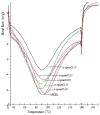Thermal Stability and Water Content Study of Void-Free Electrospun SPEEK/Cloisite Membrane for Direct Methanol Fuel Cell Application
- PMID: 30966230
- PMCID: PMC6414944
- DOI: 10.3390/polym10020194
Thermal Stability and Water Content Study of Void-Free Electrospun SPEEK/Cloisite Membrane for Direct Methanol Fuel Cell Application
Abstract
Void-free electrospun SPEEK/Cloisite15A® densed (SP/e-spunCL) membranes are prepared. Different loadings of Cloisite15A® (0.10, 0.15, 0.20, 0.25 and 0.30 wt %) are incorporated into electrospun fibers. The physico-chemical characteristics (methanol permeability, water uptake and proton conductivity) of the membranes are observed. Thermal stability of all membranes is observed using Thermal Gravimetry Analysis (TGA). The thrree stages of degradation range between 163.1 and 613.1 °C. Differential Scanning Calorimetry (DSC) is used to study the wettability of the membranes. SP/e-spunCL15 shows the lowest freezing bound water of 15.27%, which contributed to the lowest methanol permeability. The non-freezing bound water that proportionally increased with proton conductivity of SP/e-spunCL15 membrane is the highest, 10.60%. It is suggested that the electrospinning as the fabricating method has successfully exfoliated the Cloisite in the membrane surface structure, contributing to the decrease of methanol permeability, while the retained water has led to the enhancement of proton conductivity. This new fabrication method of SP/e-spunCL membrane is said to be a desirable polymer electrolyte membrane for future application in direct methanol fuel cell field.
Keywords: electrospinning; membrane; thermal analysis; wettability.
Conflict of interest statement
The authors declare no conflict of interest
Figures










References
-
- Wan N. High performance direct methanol fuel cell with thin electrolyte membrane. J. Power Sources. 2017;354:167–171. doi: 10.1016/j.jpowsour.2017.04.037. - DOI
-
- Masdar M.S., Zainoodin A.M., Rosli M.I., Kamarudin S.K., Daud W.R.W. Performance and stability of single and 6-cell stack passive direct methanol fuel cell (DMFC) for long-term operation. Int. J. Hydrog. Energy. 2017;42:9230–9242. doi: 10.1016/j.ijhydene.2016.07.123. - DOI
-
- Das V., Padmanaban S., Venkitusamy K., Selvamuthukumaran R., Blaabjerg F., Siano P. Recent advances and challenges of fuel cell based power system architectures and control—A review. Renew. Sustain. Energy Rev. 2017;73:10–18. doi: 10.1016/j.rser.2017.01.148. - DOI
-
- Branco C.M., Sharma S., de Camargo Forte M.M., Steinberger-Wilckens R. New approaches towards novel composite and multilayer membranes for intermediate temperature-polymer electrolyte fuel cells and direct methanol fuel cells. J. Power Sources. 2016;316:139–159. doi: 10.1016/j.jpowsour.2016.03.052. - DOI
-
- Dutta K., Das S., Kumar P., Kundu P.P. Polymer electrolyte membrane with high selectivity ratio for direct methanol fuel cells: A preliminary study based on blends of partially sulfonated polymers polyaniline and PVdF-co-HFP. Appl. Energy. 2014;118:183–191. doi: 10.1016/j.apenergy.2013.12.029. - DOI
LinkOut - more resources
Full Text Sources

